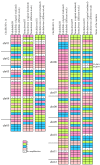The Selection of Gamma-Ray Irradiated Higher Yield Rice Mutants by Directed Evolution Method
- PMID: 32784591
- PMCID: PMC7464962
- DOI: 10.3390/plants9081004
The Selection of Gamma-Ray Irradiated Higher Yield Rice Mutants by Directed Evolution Method
Abstract
We have succeeded in selecting four higher yield mutants from five gamma-ray irradiated high-yielding Japanese rice varieties using a novel approach. A total of 464 M2 plants which had heavier total panicle weights per plant were first selected from 9801 irradiated M2 plants. Their higher yields were confirmed by yield trials conducted for three years with a six to ten-pairwise replicated plot design. FukuhibikiH6 and FukuhibikiH8 were selected from an irradiated high-yielding variety Fukuhibiki and showed 1.2% to 22.5% higher yield than their original significantly. YamadawaraH3 was selected from an irradiated high-yielding variety Yamadawara and its yield advantages were 2.7% to 3.9%. However, there was no difference in the genotypes of the 96 SNP (single nucleotide polymorphism) markers between the higher yield mutants and their respective original varieties. The differences in the measured phenotypical traits between each mutant and its original variety were not constant and the actual differences were marginal. Therefore, the higher yields of the selected mutants were likely to have been caused by physiological traits rather than phenotypical traits. The selection method used in this study is an application of the directed evolution method which has long been commonly used in the substantial improvements of microorganisms and their proteins.
Keywords: directed evolution; gamma-ray irradiation; higher yield; mutant; physiological trait; rice.
Conflict of interest statement
The authors declare no conflict of interest.
Figures




References
-
- Hu Z., Cao L., Sun X., Zhu Y., Zhang T., Jiang L., Liu Y., Dong S., Sun D., Yang J., et al. Fine mapping of a major quantitative trait locus, qgnp7(t), controlling grain number per panicle in African rice (Oryza glaberrima S.) Breed. Sci. 2018;68:606–613. doi: 10.1270/jsbbs.18084. - DOI - PMC - PubMed
LinkOut - more resources
Full Text Sources

